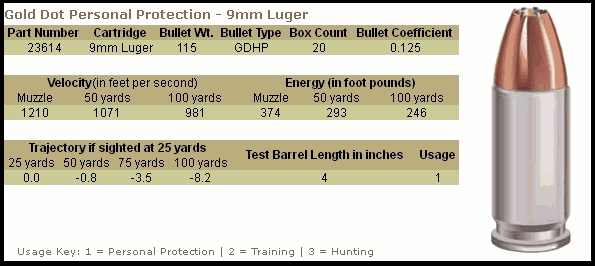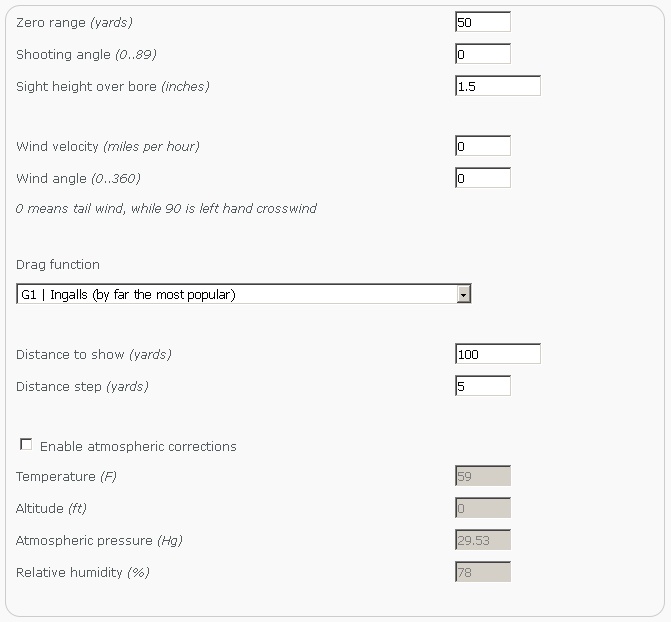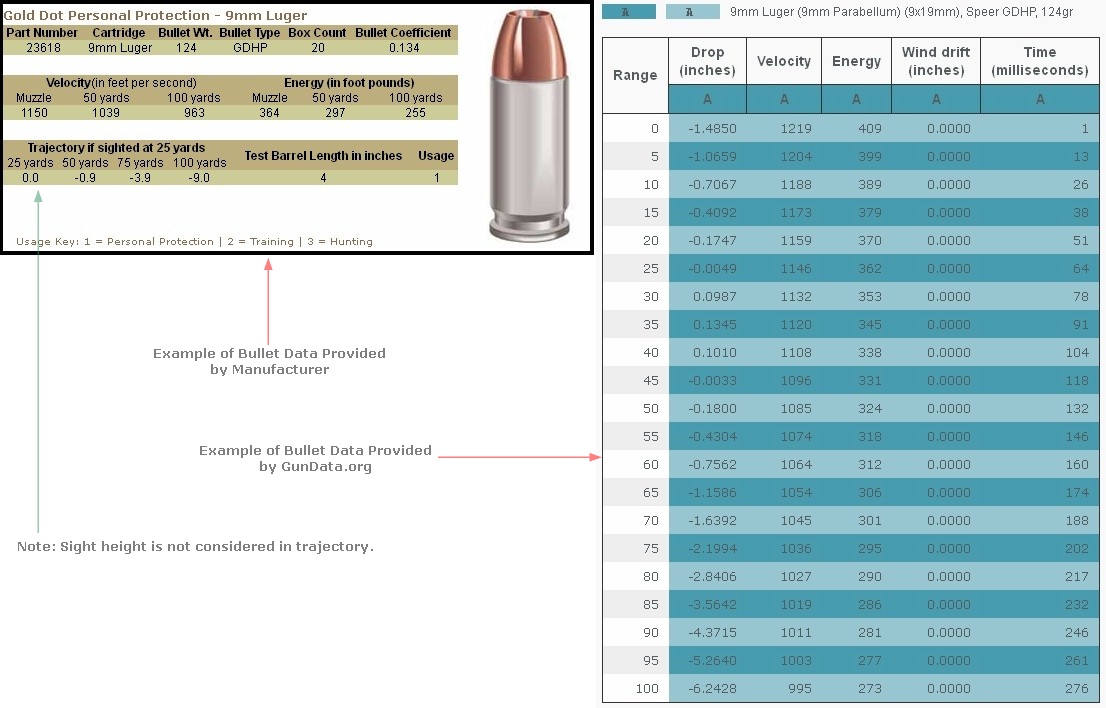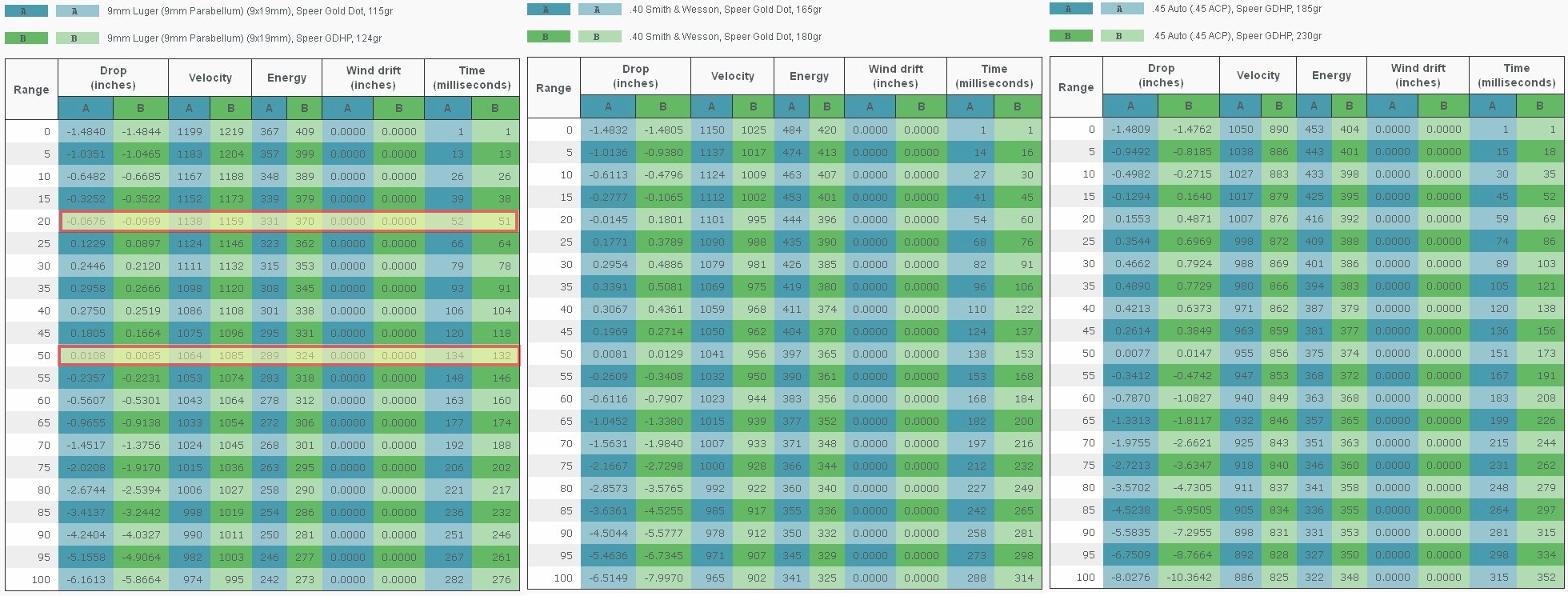I thought that I would title this piece with a quote from Sidney J. Harris (https://en.wikipedia.org/wiki/Sydney_J._Harris), an American journalist for the Chicago Daily News and, later, the Chicago Sun-Times.
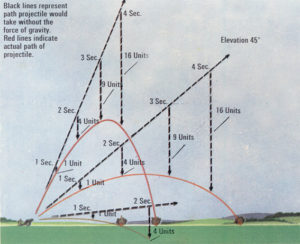 Trajectory, as we know, is the path that a moving object follows through space as a function of time. Every moving object has a trajectory, and since those who are reading this article are probably operators of firearms, trajectory has a special meaning. However, the trajectory of a bullet that is spinning out of the end of a firearm’s barrel means different things to different shooters. Trajectory only becomes important as the distance at which a bullet is traveling increases, but at what point in a bullet’s travel does trajectory become important? I believe that the answers would be wide and varied, depending upon to whom the question is asked.
Trajectory, as we know, is the path that a moving object follows through space as a function of time. Every moving object has a trajectory, and since those who are reading this article are probably operators of firearms, trajectory has a special meaning. However, the trajectory of a bullet that is spinning out of the end of a firearm’s barrel means different things to different shooters. Trajectory only becomes important as the distance at which a bullet is traveling increases, but at what point in a bullet’s travel does trajectory become important? I believe that the answers would be wide and varied, depending upon to whom the question is asked.
To hunters (handgun or rifle), extreme long-range, and precision shooters (handgun or rifle), trajectory is really important. To us folks who use firearms for defensive purpose, mostly handguns, trajectory may not play into our considerations for using a hand gun at short distances, but should it?
When at my local and favorite indoor range, I observe that most handgun shooters (and I include myself in that observation) practice at distances from five yards to fifteen yards. We have been indoctrinated that “combat” distance is twenty-one feet (7 yards) and that is the most common distance that I see targets placed. However, and in my vein of reality, I believe that a threat can be presented at any distance and that I may need to address that threat if I cannot evade and escape from it. Therefore, knowing (or at least having a passing understanding) of what the combination of bullet, firearm, and my capabilities of handling both, is somewhat important to me.
The maximum distance when I was qualifying with my duty weapon, and when competing in police bulls-eye matches, was twenty-five yards. While twenty-five yards sets a good baseline, the bullet does not stop at that distance. I am not only responsible for when the bullet leaves the barrel; I am also responsible for what that bullet is doing at distance – short and long. I consider it my responsibility to understand the ballistics associated with the projectile that I shoot out of the barrel of the firearm from which the projectile is being shot.
While the study of trajectory would make a mathematician drool, this article is not about juggling numbers (I have included a couple of links at the end of the article for those who are interested in formulas and what not), this article is more about presenting the end result of trajectory formulas, and I’ll rely on a couple of sources to provide me with that information, one source of which is more precise than the other and allows me to produce graphs of various bullet comparisons in regards to trajectory.
This article is not about long-range shooting, although some may consider 100 yards as long range shooting for a handgun. The trajectory information that I present in charts and graphs stop at 100 yards simply because I think that is a good place to stop for the sake of this presentation. Again, it does not signify that a projectile fired from a handgun will stop at 100 yards.
This article is not about shooting at extreme angles, which is a separate study in its own right. All data is presented from the perspective of level barrels with and without sights, although I may show trajectory differences from various sight heights to illustrate the effects of sight height on a trajectory path.
This article is not about what projectile is the best. We are simply going to look at some trajectories out of a test barrel a particular bullet commonly used for self-defense. We are also going to look at the trajectories in terms of bullet drop under ideal test conditions, which means that the results will be different from that found from your gun, your, barrel, and not-so-ideal real-world conditions. In that sense, consider the information presented as simply for general reference and entertainment purposes.
For the purpose of this article, I am going to select two bullet weights of three common defensive pistol calibers; 9mm (115-grain and 124-grain), 40 Smith and Wesson (165-grain and 180-grain), and .45 ACP (185-grain and 230-grain). I also want to select the cartridges that fire these bullets from the same manufacture; in this case the Speer and the GDHP (Gold Dot Hollow Point) is my choice since it is a commonly-accepted and highly-regarded defensive round.
The animation that follows provides ballistic data for each one of the cartridges that will be presented in this article.
So, let’s head on down the trajectory path, or as we could label it in French, La Chemin de la résistance – The path of resistance!
LE CHEMIN DE LA RÉSISTANCE!
As we know, once a bullet leaves a constricted space (the cartridge case) under extreme pressure, it soon enters another constricted space (the barrel) after a short “Leade” time. Now, with angular rotation (spin) and forward velocity, it enters a set of restrictions that not only affects the bullet’s rate of travel but also the direction of travel. I guess that in a sense, you could call it “restrictive air space?”
And, not only do we have the environmental impact on a bullet, the bullet itself has an intrinsic value called the BC (Ballistic Coefficient), which is presented in the equation that follows:
Where:
BCProjectile = ballistic coefficient as used in point mass trajectory from the Siacci method (less than 20 degrees).
m = mass of bullet in kg or lb
d = measured cross section (diameter) of projectile in m or in
i = Coefficient of form
To cut to the chase for the purpose of this article; the Ballistic Coefficient for each of the bullets to be discussed is as follows:
Table 1. Speer Gold Dot Hollow Point Ballistic Coefficients
| Caliber | Bullet Weight (gr.) | Ballistic Coefficient |
| 9mm | 115 124 |
.125 .134 |
| .40 Smith and Wesson | 165 180 |
.138 .143 |
| .45 ACP | 185 230 |
.109 .143 |
What you might be surprised to see is that the Ballistic Coefficient for the .40 caliber Speer 180-grain GDHP is the same as the .45 ACP Speer 230-grain GDHP. Interesting, huh?
WHAT A DRAG!
For the sake of this discussion, I am using the on-line Ballistics Calculator from GunData.org. Initially, I simply select the cartridge and the program displays the following for viewing:
- Bullet caliber
- Bullet name
- Ballistic coefficient
- Initial velocity (feet per second)
- Bullet weight (grains)
Next, I can enter or select “Advanced Options” of which are shown below. Note that for the purpose of this article, and for the sake of simplicity, I will use 50 yards as my zero for all cartridges and the commonly found 1.5-inch sight height. I want the result shown at my 100-yard limit and in 5 yard increments.
Also for the sake of simplicity, I will simply accept the presented atmospheric conditions.
At a later time, I will show the difference between one cartridge’s ballistics with and without sight height. There is two different ways to show the calculated data, in table form or graph form. I like both ways, and while I do enjoy seeing things in tables, I am image oriented and also like to see things graphically. I’ll present both and let you decide your preference.
NOTES
- The information that follows contains images suitable for adult shooter viewing. Discretion is not advised nor considered. To view a larger version of any image, simply click the image to view it in a separate viewer.
- Although most ammunition manufacturers provide ballistic data on their cartridges, the data is limited in scope, in my opinion. On-line resources like GunData.org allow me to view ballistic data the way that I want to view ballistic data.
- One thing that I would like to bring out is that the trajectory is provided under the assumption that the front and rear sights (or optic) are adjusted such to provide a 50 yard zero. It should be obvious that if we change front and rear sights (or optic), the zero distance will change, as will the trajectory. The effects of changing sight heights is shown later in the article.
PUTTING IT ALL ON THE TABLE:
The GunData.org ballistic calculator allows me to get a good look at data associated with any cartridge selected from the Bullet Name listing according to the caliber selected from the Bullet Caliber listing.One advantage of using GunData.org is that you can set your own zero rather than be dependent upon the zero provided by the manufacturer. For example, Speer provides ballistic data on all of their cartridges, and which you can retrieve from their website. However, all pistol cartridge ballistic data is for a zero at twenty-five yards with trajectory data provided at fifty yards, seventy-five yards, and one-hundred yards only. The GunData.org website allows you to plug in whatever zero distance that you want, the maximum range, and the trajectory path in increments that you choose. An example of the difference between what is provided by the manufacturer (in this case Speer) and GunData.org is shown below.
The GunData.org ballistic calculator allows the comparison of two cartridges of any caliber by any manufacturer included in the Bullet Name listing. For my purposes, and for the purpose of this article, I wanted to compare two specific cartridges by the same manufacturer in each of the popular defense calibers; 9mm, .40 Smith & Wesson, and .45 ACP. I can pick out differences in trajectory, velocity, and energy (among others) and determine if one cartridge is really any better than another.In the composite image that follows, comparison tables show each ballistic data chart for two selected cartridges in 9mm, .40 Smith & Wesson, and .45 ACP calibers.
CHARTING THE COURSE:
The GunData.org ballistic calculator allows the trajectory comparison, in graph form, of one or two cartridges of any caliber by any manufacturer included in the Bullet Name listing.
In the composite image that follows, I have a visual reference that shows me the comparative trajectories for each of the selected cartridges in 9mm, .40 Smith & Wesson, and .45 ACP that, in this case is Speer GDHP cartridges.
As I mentioned earlier, sight height does affect trajectory. With the data provided by Speer for the examples used in this article, the trajectories do not take into consideration for sight height.
Using GunData.org, I can also present the ballistics data without consideration for sights (bore-sighted), or I can enter values for the sight height used on my particular firearm; iron or optic.
The compilation below shows the effect on trajectory for three different sight heights.
IT IS NOT WHAT YOU HAVE, BUT IT IS HOW YOU USE IT
Your shooting buddy has just told you that he only carries a certain brand and type of round because it is the best defensive cartridge and is recommended by blah blah, blah blah, and blah blah and who are experts in ballistics. Do you take his word for it or are you the type that wants to know why. If you are the type that wants to know why, you are going to be looking into things that matter; trajectory, velocity, and energy of his recommended cartridge and compare that information with one or more others in the same caliber.
It may also be that you have just bought a new pistol, revolver, rifle, or carbine and are simply looking for different types of ammunition that is available for them. You have a plethora of cartridges to select from and you drool like one of Pavlov’s dogs when faced with them at your local gun shop or big box store. Whether you are looking for some simple target ammunition or the best cartridge for defense or hunting, the selection can bring about levels of indecision on your part. I know that you have been told to shoot at the range a cartridge that closely approximates what you carry for defense ammunition – so why not do some research and find an inexpensive “target” round that closely approximates what you carry?
If you have paid attention to the charts and graphs that I have presented thus far, you may realize that there is no magical formula and there is not a great difference in bullet performance within a family of bullets of the same manufacturer and the same caliber. Is a bigger bullet better? Through some research, you can determine if that can be question can be answered.
Through some research, you may also be able to determine what “range” ammunition might come close to your “carry” ammunition. If you hand-load your own ammunition, you can use ballistic data from manufactures to create your own recipes that closely match the ballistics of factory ammunition, because lets face it, ammunition manufactures are not going to give up their “secret” recipes any more than a good chili chef or slow-cook barbecue specialist would reveal the “secret” ingredient in the award-winning recipe.
DRAWING A COMPARISON:
By using tabulated and graphical ballistic data, we can compare certain aspects of one or more cartridges for comparison. For example, the “energy” aspect is something to be considered in a cartridge that is used for self-defense or hunting.I can see that at somewhere around twenty-yards, the difference in trajectory is quite noticeable between the Speer .40 S&W 180-grain GDHP and that the Speer .45 ACP 230-grain GDHP.
In the examples that I have presented, I also noticed that although the Speer .40 S&W 180-grain GDHP has greater energy out to about 30-yards than the Speer .45 ACP 230-grain GDHP. In fact, the energy values are nearly equal at 30 yards (385 ft. lbs. vs. 386 ft. lbs.Beyond 30 yards; however, the Speer .45 ACP 230-grain GDHP sheds energy at a slower rate than the Speer .40 S&W 180-grain GDHP and that the Speer .45 ACP 230-grain GDHP actually has more energy at 50 yards (374 ft. lbs. vs. 365 ft. lbs.) than the Speer .40 S&W 180-grain GDHP.Energy; however, will be a topic of later discussion.
Granted that there are more comparisons to be performed and evaluated.
COMING TO SOME KIND OF CONCLUSION:
When firearm manufacturers create a firearm, very little is known by the user regarding the test cartridges that are used by the manufactures. We sometime heavily rely on data provided by the firearm manufacturer regarding their product just as we do with ammunition manufacturers on their ammunition.
The path (trajectory) that a bullet takes after leaving the barrel of a firearm on will not be the same as that presented by ballistic tables and charts – regardless of the source.
Ballistic tables and graphs provide us with a general idea of what a projectile should do, but is still ambiguous at best.
What is more important is what a projectile does out of the barrel of your firearm under the conditions it is subjected to, and those conditions can change at any time. What ballistic tables provide to us is expectations; expected results that are based upon unknown (to us) barrels under derived conditions in most cases. How many times have we been disappointed by expectations?
While I have purchased expensive ammunition that performed poorly through a firearm, I have also purchased inexpensive ammunition that performed wonderfully through same firearm. It is all one big experiment, folks.
In short, trust your own observations with your firearms and cartridges of choice.Lastly, and like in life, the path that your bullet takes is not as important as what is does when it reaches its destination. This is one case where you hope the what happens at the destination is worth the trip.
RESOURCES:
- Trajectory: https://en.wikipedia.org/wiki/Trajectory
- Range of a projectile: https://en.wikipedia.org/wiki/Range_of_a_projectile
- Trajectory of a projectile: https://en.wikipedia.org/wiki/Trajectory_of_a_projectile
- Ballistic coefficient: https://en.wikipedia.org/wiki/Ballistic_coefficient
- Speer Ballistic Tables (Handgun): http://www.speer-ammo.com/ballistics/ammo.aspx
IMAGE LINKS – MANUFACTURER BALLISTICS:
For your convenience, and if you are interested in any of the Speer Gold Dot Hollow Point products use in this article, I have provided links below, which when clicked, opens the ballistic data in a new tab for viewing.
- Speer 9mm 115-grain Gold Dot Hollow Point: https://guntoters.com/blog/wp-content/uploads/2016/07/GDHP_115.jpg
- Speer 9mm 124-grain Gold Dot Hollow Point: https://guntoters.com/blog/wp-content/uploads/2016/07/GDHP_124.jpg
- Speer 40 Smith and Wesson 165-grain Gold Dot Hollow Point: https://guntoters.com/blog/wp-content/uploads/2016/07/GDHP_165.jpg
- Speer 40 Smith and Wesson 180-grain Gold Dot Hollow Point: https://guntoters.com/blog/wp-content/uploads/2016/07/GDHP_180.jpg
- Speer .45 ACP 185-grain Gold Dot Hollow Point: https://guntoters.com/blog/wp-content/uploads/2016/07/GDHP_185.jpg
- Speer .45 ACP 230-grain Gold Dot Hollow Point: https://guntoters.com/blog/wp-content/uploads/2016/07/GDHP_230.jpg
![]()


